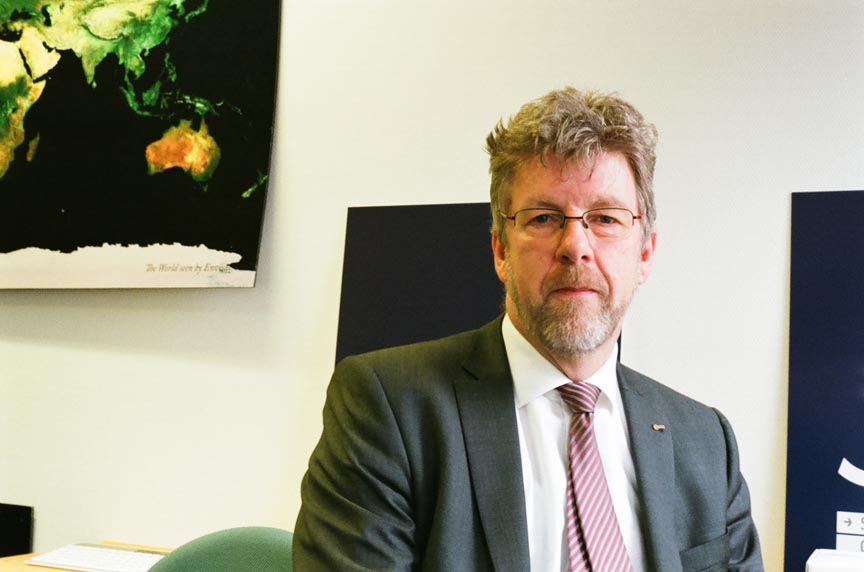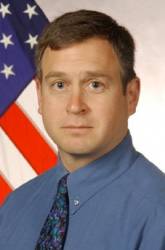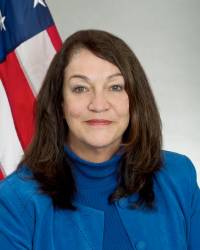Last February, Paul Verhoef took up the directorship of ESA’s Galileo Program and Navigation-related Activities, and he hasn’t had time to look back since. The successful launch on May 25 2016 of two more satellites is just one of many milestones stretching ahead of him.
Last February, Paul Verhoef took up the directorship of ESA’s Galileo Program and Navigation-related Activities, and he hasn’t had time to look back since. The successful launch on May 25 2016 of two more satellites is just one of many milestones stretching ahead of him.
“We have our hands full,” he says, speaking to us at ESA’s offices in Brussels. “We released recently a tender for the next batch of satellites. There is a tender coming up for ‘systems support,’ there is a tender for a new ground control segment contract, and one for a ground mission contract. We are currently issuing tenders worth €3 to €3.5 billion.”
And there’s more. He says, “We are overseeing the installation of new ground segments. With our current ground facilities we can handle about 18 satellites and we need to get that up to about 30.
“We are helping Member States to define Galileo’s Public Regulated Service, the PRS. We are just launching two new satellites, and before the end of the year we will launch four more. And then we have the start up of initial services also by the end of the year.”
How’s that for starters?
Wandering Star
A plain-spoken Dutch engineer, Verhoef says he’s from nowhere in particular in the Netherlands; his family moved around a bit — and so has he. Verhoef trained as an electrical engineer at Eindhoven Technical University. He has seen duty in New Zealand for Philips Electrical Industries, and he worked for the United Nations in Fiji, where, among other things, he supervised the installation of the first satellite Earth station in Papua New Guinea, used for international communications links in the South Pacific.
In the 1980s he worked in Paris for Eutelsat and in the Netherlands at ESA’s European Space Research and Technology Centre (ESTEC) in Noordwijk, Netherlands. Then he moved to Brussels and the European Commission (EC).
Verhoef’s face and frame will already be familiar to many in the GNSS community. From 2005 to 2011, he was Galileo and EGNOS satellite navigation program manager at the commission, working in close cooperation with ESA and the European GNSS Agency (GSA). During those years, he was a well-recognized speaker on the EU space policy circuit.
In between then and now, Verhoef was called away to set up a new Research and Innovation team within the Commission’s Directorate General for Transport and Mobility (DG-MOVE) and he subsequently served as Head of Unit for “Renewable Energy Sources” at the EC’s DG Research and Innovation (RTD).
Now back in the space race working for ESA, Verhoef splits his time between the agency’s headquarters in Paris and the European capital, Brussels, where he still lives with his family.
To hear him speak, one might think Galileo is building up a head of steam. It wasn’t always that way. The past few years have seen delays and setbacks, along with some successes. Verhoef finds nothing surprising in that.
“It’s not unusual to see problems with a project like this,” he says. “This is an extremely complex program, involving the most advanced technologies. We are talking about operating upwards of 24 individual satellites, and we know how to do this, but it is only the functioning of the total constellation together, as one system, that gives you anything like a GNSS service. So this is very complex. But the problems we have seen in the past are not anything we cannot overcome.”
He adds, “GPS took 24 years to set up. We will be quicker. We always knew it would take time — and it will still take more time — but we need to do this right, and when it is done we will need to stabilize it.”
New Thing
Having worked as top Galileo man at the commission, and now as ESA’s Galileo director, Verhoef is unlike anyone who has come before him. He knows intimately the inner workings — as well as the fears, hopes, and dreams — that reign at the highest levels on both sides of the EC-ESA divide.
“Divide” might not be the most comfortable descriptor, but then again it might be the right one. We have reported over several years on the rocky road these two very big organizations have had to walk together, sometimes holding hands and sometimes knocking elbows.
The third member of the Galileo triangle is the European GNSS Agency (GSA), headquartered in Prague and led by Carlo des Dorides, another of Verhoef’s old acquaintances.
As it is currently formulated, Verhoef says, “The GSA was set up in 2010–11, and we are now in a phase of transferring Galileo operator status from ESA to the GSA. We still have work to do to organize the way we interact. It implies responsibilities and liabilities, and it requires the approval of the GSA board and ESA Council.”
So-called “governance issues” have been cited, and blamed, seemingly endlessly over the history of the Galileo program, and ESA and the European Commission work together on many other projects as well, including EGNOS, Europe’s satellite-based GNSS augmentation system, and the Copernicus Earth observation program.
Simply Complex
Last year, one ESA official, speaking about numerous and disparate EC-ESA agreements and working arrangements, told us, “The content of each agreement is different, and we have different roles to play, depending on the agreement. We have to change our hats each time. For some projects we act as prime contractor, for others it’s something different.”
Verhoef says, “Yes, all those working arrangements, all those different programs, each one is very specific, with different ways of transaction. Should we try to simplify? Yes, we should. Are the EGNOS and Galileo arrangement too complicated? Maybe, yes.
“We have the GSA, we have ESA and the Commission. We have different groups, councils and program committees, and the GSA board. And there is probably some overlap. There are a lot of resources tied up in coordination, and we know this is not what the taxpayer expects.
“But this is a process,” he contends, “and things cannot be changed overnight. What we are doing now is working on how to do things more simply.”
The new generation of GNSS leadership in Europe, with des Dorides in Prague, Mathias Petschke at the European Commission, and Verhoef at ESA, with Johann-Dietrich Wörner now heading that agency, seems to be getting closer to forming what one might call a real team, working together in common appreciation. The age of the dinosaurs may be coming to a close.
But Verhoef does not see this process as an end in itself. There will be more work for the team after Galileo is completed.
Future Vision
“Soon we will be moving from one system, GPS, to four operating global systems and numerous regional systems,” Verhoef says. “We will have very precise positioning.” The receivers being sold today already have the capability to receive BeiDou, GLONASS, and Galileo. Accuracy for everyone will be in the range of centimeters.
“Galileo on its own will be a solution for particular things like the PRS [the encrypted Public Regulated Service],” he says. And there will be new fields of application. Some are obvious, such as rail transport, where, he says, Galileo and EGNOS will eliminate the need for expensive infrastructure of various sorts. Others have not yet been imagined.
And there will also be limitations. Because of their inherent weak signal strength, GNSS signals are not available in tunnels, inside buildings, and in other difficult environments, and they never will be.
“Galileo is not the one and only system that will solve every problem in the world,” Verhoef says. “GNSS will contribute its part, but we will have to combine GNSS with terrestrial and inertial systems to get complete coverage.”
Obsolescence, he accepts, is inevitable. “Satellites live for 15 years, computer systems are constantly being upgraded. We are constantly looking at new technologies.”
And, he agrees, we have to talk about GNSS vulnerability. “Jamming and spoofing are illegal,” he says, “but they are still there. With such a large part of the economy now dependent on GNSS, we cannot pretend, we cannot ignore the problem of vulnerability, we must address it.”
Technologies such as eLoran, Verhoef says, completely separate and independent of GNSS technologies, are still a valid topic for discussion: “eLoran is not expensive, and it could provide a back-up system for critical positioning and navigation,” he says.
But he adds, “We have issues with all technologies. You can always come up with ‘what-ifs.’ Think about your car: you have one spare tire, not four, but you get to your destination all the same.
“We need to be pragmatic and we need to work together. And we also need to avoid becoming too focused on one issue. You know, we always hear about radio frequency vulnerability, but what about cyber vulnerability — the hackers? Who is talking about that? GNSS vulnerability isn’t just about weak radio signals.”
That said, Verhoef appears confident and, indeed, very busy; so, we wrap things up.
“We are preparing for initial services,” he concludes. “This is a very important moment for us. We have the infrastructure in place. Now it’s time to use it.”






